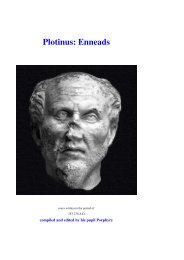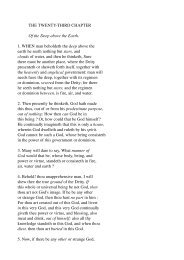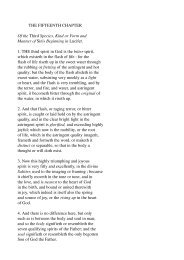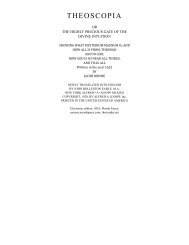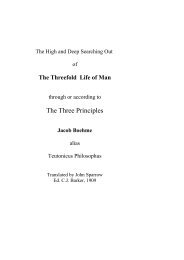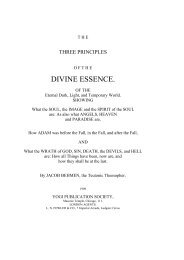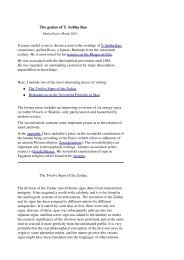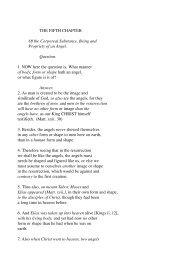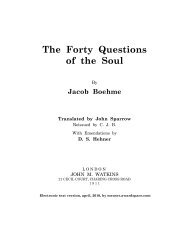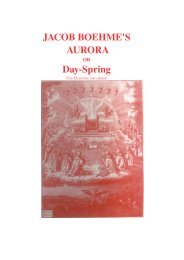Gerald Massey's Lectures - Society in evolution - Awardspace
Gerald Massey's Lectures - Society in evolution - Awardspace
Gerald Massey's Lectures - Society in evolution - Awardspace
You also want an ePaper? Increase the reach of your titles
YUMPU automatically turns print PDFs into web optimized ePapers that Google loves.
is thus cont<strong>in</strong>ued or not, it is the fact that the word "Shtar"* is the Egyptian name of the<br />
Betrothed female, and Shta denotes that which is most mystical, secret, and holy, the very<br />
mother of mystery. Ishtar was the betrothed of Tammuz; she was called the "Bridal<br />
Goddess," the goddess who was mystically betrothed to the child that grew up to become<br />
her own Consort. She rema<strong>in</strong>ed the Mother of Mystery. Thus Ishtar=Venus, the goddess<br />
of love, was the Shtar or Betrothed, as the pre-monogamic consort or bride, i.e., the<br />
"bridal goddess," who is denounced <strong>in</strong> Revelation as the Great Harlot.<br />
Aga<strong>in</strong>, it appears to me that much of what I have already said of Horus, of Taht, of<br />
Khunsu, Apollo, and other forms of the soli-lunar hero is applicable not only to Mithras<br />
but to Merodach, and to an Assyrian god called Adar (provisionally). I may claim to have<br />
discovered the orig<strong>in</strong> of this particular mythical character through seek<strong>in</strong>g the<br />
foundations <strong>in</strong> natural phenomena. Adar is a solar hero who is especially related to night<br />
and darkness, and yet is a deity of light. He is a warrior and champion of the gods. He is<br />
the voice or supreme oracle of the div<strong>in</strong>ities. He is the son, the messenger, the revealer of<br />
the Solar god hidden <strong>in</strong> the deep of the underworld. In other features he is like Taht and<br />
Khunsu, each of whom is the visible representative, the revealer, of the sun-god by night.<br />
Adar was designated "Lord of the date," just as Taht was called "Lord of the date-palm."<br />
Adar was likewise "Lord of the Pig," just as Khunsu is the personified lord over the pig<br />
of Typhon <strong>in</strong> the disk of the moon at full (Zodiac of Denderah). This is the god who, as<br />
Adonis, was sla<strong>in</strong> by the pig or boar at one season of the year, but who was victor over it<br />
<strong>in</strong> the first of the six upper signs, which is the sign of Pisces <strong>in</strong> the Zodiac of Denderah.†<br />
This same character is cont<strong>in</strong>ued <strong>in</strong> Tammuz, the deity who was first brought forth by the<br />
mother alone, to become her consort, the only one of a twofold nature; and who was<br />
made the later revealer of a Father <strong>in</strong> heaven as the child of the solar god when reborn as<br />
such of the mother-moon. The month of Tammuz <strong>in</strong> the Aramaic calendar is (roughly)<br />
our month of June. This is the month of Duzu <strong>in</strong> the Assyrian calendar. In the Egyptian it<br />
was the month Mesore, as June <strong>in</strong> the sacred year, the month of the re-birth of the river<br />
and of the child Horus, who was re-born (Mes) of the river at the re-birth of the<br />
Inundation. In the pre-Osirian Mythos the child was the representative of Tum and to be<br />
the re-born (Mes) Tum or the child of Tum, as was Iu-em-hept, the Eternal Word, would<br />
be renderable as Tum-mus or Messu, just as Ra-messu means the child of the solar god,<br />
although I am not aware that Tum does appear under that form of name, and I am<br />
suppos<strong>in</strong>g that Tammuz was a development from the Egyptian Tum. For this reason! We<br />
are told <strong>in</strong> the texts‡ that Tum is the duplicate of Aten=Adon=Adonai; and Adon =<br />
Tammuz. Aten was the child-God; Tum was the father. This child of the sun-god was<br />
always born <strong>in</strong> the moon as the solar light of the world by night, the son of the Spirit of<br />
the deep who was the hidden sun <strong>in</strong> the under-world. He is pourtrayed <strong>in</strong> the disk of the<br />
full-moon both as Horus (or Tum-mes) and<br />
________________________________________________________________________<br />
* Champollion. Gram : 1292. † Macrobius, Saturn. 121. ‡ Records 4.95.<br />
Khunsu (Planisphere and Zodiacs of Denderah). Now, when the actual deluge began with<br />
the sun <strong>in</strong> the sign of the Beetle (later Crab), and <strong>in</strong> the month of Tammuz or Mesore, the<br />
moon rose at full <strong>in</strong> the sign of the sea-goat, and the child was therefore reborn of the full<br />
moon <strong>in</strong> that sign, and so on through the three water signs, which are consequently solar<br />
on one side of the Zodiac and lunar on the other! Rightly read this absolutely proves the<br />
Egyptian orig<strong>in</strong> of the signs set <strong>in</strong> heaven <strong>in</strong> relation to the Inundation, the lunar zodiac<br />
be<strong>in</strong>g first, and identifies the child of Tum as the orig<strong>in</strong>al of the Akkadian Dumu-zi-<br />
Apzu, and of the Semite "Timmuz (or Dimmuz) of the Flood;"* not Noah's unfortunate<br />
deluge, but the <strong>in</strong>undation of the Nile, the deluge that began <strong>in</strong> the month Mes-Horus or<br />
Tum-Mes=Tammuz, and culm<strong>in</strong>ated at the autumn equ<strong>in</strong>ox as it always has done, and<br />
did this year. The Akkadian name of the month Tammuz is Su-Kul-na, "seizer of seed,"



